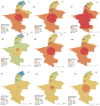Effect of Terroir on Phenolic Content and Aroma Properties of Grapes and Wines
- PMID: 40282810
- PMCID: PMC12026802
- DOI: 10.3390/foods14081409
Effect of Terroir on Phenolic Content and Aroma Properties of Grapes and Wines
Abstract
Ten vineyards, belonging to five wine regions, were selected in this study. Maturity indicators and phenolic and aromatic compounds were measured to investigate relationships with factors related to the terroir, including climate conditions and soil nutrients. Multiple factor analysis of all compositions showed that different wine regions or vineyards had different characteristics, which were partly associated with the terroir. The results showed that Shizuishan had high sugar content. A high level of anthocyanins could be found in Qingtongxia and Yongning, respectively. Moreover, Qingtongxia had higher concentrations of monomeric phenols in grapes than the others. LSYH (Lanshanyunhao) and LL (Lilan) had higher YAN (yeast assimilable nitrogen) content and pH in grapes, but their wine had a green flavor (high concentration of alcoholic volatile compounds). The Shizuishan and Hongsipu wine regions had fruitier flavors (high concentration of ester volatile compounds). This study demonstrated the characteristics of different vineyards and wine regions, providing a direction for the future development of region-specific grapes and wines.
Keywords: phenolic compounds; terroir; vineyards; volatile compounds; wine regions.
Conflict of interest statement
The authors declare no conflicts of interest.
Figures




Similar articles
-
Volatile Profiles and Sensory Characteristics of Cabernet Sauvignon Dry Red Wines in the Sub-Regions of the Eastern Foothills of Ningxia Helan Mountain in China.Molecules. 2022 Dec 12;27(24):8817. doi: 10.3390/molecules27248817. Molecules. 2022. PMID: 36557951 Free PMC article.
-
Sub-Regional Variation and Characteristics of Cabernet Sauvignon Wines in the Eastern Foothills of the Helan Mountain: A Perspective from Phenolics, Visual Properties and Mouthfeel.Foods. 2023 Mar 3;12(5):1081. doi: 10.3390/foods12051081. Foods. 2023. PMID: 36900598 Free PMC article.
-
Comparison of fortified, sfursat, and passito wines produced from fresh and dehydrated grapes of aromatic black cv. Moscato nero (Vitis vinifera L.).Food Res Int. 2017 Aug;98:59-67. doi: 10.1016/j.foodres.2016.11.012. Epub 2016 Nov 12. Food Res Int. 2017. PMID: 28610733
-
Effects of sugar concentration processes in grapes and wine aging on aroma compounds of sweet wines—a review.Crit Rev Food Sci Nutr. 2015;55(8):1053-73. doi: 10.1080/10408398.2012.680524. Crit Rev Food Sci Nutr. 2015. PMID: 24915355 Review.
-
The Actual and Potential Aroma of Winemaking Grapes.Biomolecules. 2019 Dec 3;9(12):818. doi: 10.3390/biom9120818. Biomolecules. 2019. PMID: 31816941 Free PMC article. Review.
Cited by
-
Volatilome Analysis for Differentiating Terroir Expression: A Case Study of Three Wineries in a Limestone-Rich, Warm-Climate Region.Molecules. 2025 Jul 16;30(14):2982. doi: 10.3390/molecules30142982. Molecules. 2025. PMID: 40733248 Free PMC article.
-
Exploring the Bioavailability of Red Grape Skin Extract Polyphenols: A Caco-2 Cell Model Study.Foods. 2025 Jun 25;14(13):2253. doi: 10.3390/foods14132253. Foods. 2025. PMID: 40647004 Free PMC article.
References
-
- Foroni F., Vignando M., Aiello M., Parma V., Paoletti M.G., Squartini A., Rumiati R.I. The smell of terroir! Olfactory discrimination between wines of different grape variety and different terroir. Food Qual. Prefer. 2017;58:18–23. doi: 10.1016/j.foodqual.2016.12.012. - DOI
-
- Meinert L.D. The Science of Terroir. Elements. 2018;14:153–158. doi: 10.2138/gselements.14.3.153. - DOI
Grants and funding
- 2024BBF01002-04/Ningxia Hui Autonomous Region Key Research and Development Program
- 32372645/National Natural Science Foundation of China
- 2024QCY-KXJ-098,2023KXJ-008/the Science and Technology Development Plan Project of Shaanxi Province
- CARS-29-zp-6/the China Agriculture Research System of MOF and MARA
LinkOut - more resources
Full Text Sources

